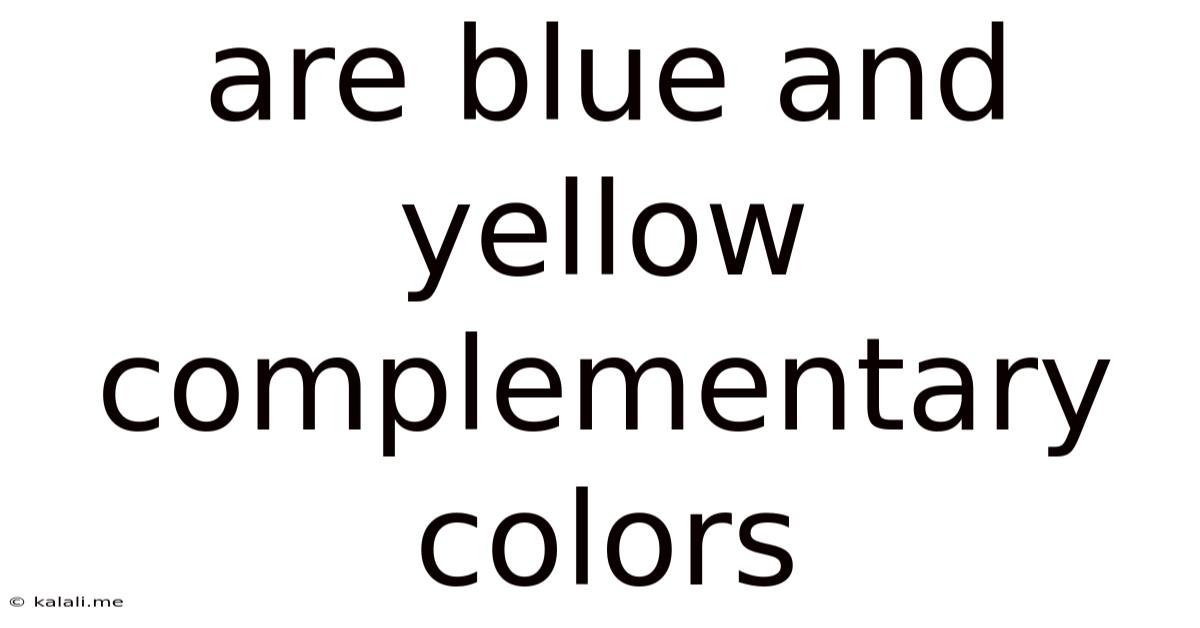Are Blue And Yellow Complementary Colors
Kalali
Jun 11, 2025 · 3 min read

Table of Contents
Are Blue and Yellow Complementary Colors? Understanding Color Theory
Are blue and yellow complementary colors? The short answer is: no, not exactly. While they appear opposite each other on some color wheels, the relationship is more nuanced than a simple "yes" or "no." This article delves into the intricacies of color theory to explain why. Understanding complementary color schemes is crucial for artists, designers, and anyone aiming for visually appealing and impactful projects.
Understanding the concept of complementary colors is fundamental in design and art. Complementary colors, in the simplest terms, are colors that are directly opposite each other on the color wheel. When placed side-by-side, they create a vibrant and high-contrast effect. When mixed together, they often create a neutral color like brown or gray.
However, the specific color wheel used significantly influences the results. There are several color models, each with its own variations:
-
RYB (Red-Yellow-Blue): This traditional color model, often taught in art classes, positions blue and yellow as primary colors. However, mixing them doesn't directly yield a neutral gray or brown, but instead, a shade of green. Therefore, strictly speaking, they are not complementary in this model.
-
RGB (Red-Green-Blue): This additive color model, used in digital displays, doesn't feature yellow as a primary color. Yellow is created by mixing red and green. In this model, blue’s complement is actually orange (a mix of red and yellow).
-
CMYK (Cyan-Magenta-Yellow-Key/Black): This subtractive color model is used in printing. Here, yellow's complement is blue, but again, the results differ depending on the exact shades and inks used. A true neutral is rarely achieved through a direct mix.
The Importance of Hue, Saturation, and Value
The complexity arises because the simple idea of "blue" and "yellow" is insufficient. These are broad categories. The specific hue (the pure color), saturation (intensity of color), and value (lightness or darkness) dramatically affect the perception of these colors and their relationship.
A bright, saturated yellow might appear complementary to a deep, desaturated blue, creating a striking contrast. However, a pale yellow paired with a light blue would result in a much less vibrant and impactful pairing. Therefore, the "complementarity" is contextual and depends on the precise shades used.
Alternative Color Harmonies Involving Blue and Yellow
While not strictly complementary, blue and yellow can be part of several effective color harmonies:
-
Analogous Colors: Using colors that are next to each other on the color wheel, like blue, blue-green, and green, creates a harmonious and soothing effect. Yellow can be introduced subtly to add warmth.
-
Triadic Colors: A triadic harmony uses three colors equally spaced on the color wheel. For instance, blue, yellow, and red could form a vibrant and balanced palette.
-
Split Complementary: This uses a base color and the two colors adjacent to its complement. For example, using yellow as the base, the split complement would be blue-violet and blue-green.
In conclusion, while the simplistic color wheel might suggest blue and yellow are complements, a deeper understanding of color theory reveals that their relationship is more intricate. The specific shades used, and the color model employed, significantly influence the outcome. Instead of focusing solely on strict complementarity, exploring various color harmonies that include blue and yellow can offer equally appealing and effective results for your creative projects.
Latest Posts
Latest Posts
-
How Many Tbsp In A Dry Ounce
Jul 02, 2025
-
How Do You Say Grandparents In Spanish
Jul 02, 2025
-
How Many Numbers Are Between 48 To 24
Jul 02, 2025
-
How Many Positions Are There In Sex
Jul 02, 2025
-
How Many Minutes Are In 10 Miles
Jul 02, 2025
Related Post
Thank you for visiting our website which covers about Are Blue And Yellow Complementary Colors . We hope the information provided has been useful to you. Feel free to contact us if you have any questions or need further assistance. See you next time and don't miss to bookmark.